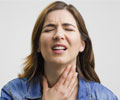About
Strep throat is a bacterial infection caused by Group A beta hemolytic streptococci. It affects most commonly infants and elderly people but adults and older children can also be affected.
It is more prevalent during winter season. It affects soft palate and tonsillar region resulting in redness. The symptoms take around 3 days after exposure to appear in an infected individual.
Classic picture of strep throat is an inflamed red oral cavity and throat with swollen tonsils with pus-filled pockets. Cervical lymphadenopathy, small swellings in the neck region, are present.

Diagnosis is made with the help of the following:
- Throat swab for culture
- Rapid antigen detection test with a throat swab.
Presentation differs with age:
- Infants present with low grade fever, loss of appetite, irritability and purulent nasal discharge.
- Older children may complain of headache, difficulty swallowing, pain under the lower jaw (due to swollen lymph glands) and hoarse voice.
- Adults may experience mild symptoms or may not have any symptoms.
Other conditions can also present with similar set of symptoms. They are listed below:
- Viral infections - Viral infections may present with running nose, sore throat, loss of appetite and muscle aches. Fever may or may not be present. Nasal discharge is usually clear and runny. They are most commonly associated with seasonal changes. Common viruses that can cause these symptoms include rhino virus, adenovirus, EBV, cytomegalovirus etc.

- Bacterial Pharyngitis - Bacterial pharyngitis is most commonly caused by Group A beta hemolytic streptococci, but other bacteria like streptococcus group C, G., Moraxella catarrhalis, Neisseria gonorrhea and fusobacterium can also cause pharyngitis. Throat swab culture can help in confirmation of diagnosis.
- Infectious Mononucleosis - Infectious mononucleosis is caused by Epstein barr virus and is usually self limiting. It affects young individuals and adults. Along with pharyngitis, it also presents with flu-like symptoms, enlarged tonsils, enlarged lymph nodes, red spots on the palate, enlarged spleen and mild jaundice. Diagnosis is confirmed with monospot test.
- Hand-foot-and-mouth disease - Hand-foot-and-mouth disease is caused by Coksackie virus. Its oral manifestations might mimic symptoms of strep throat, but in combination with skin symptoms, it gives a classic picture suggestive of hand-foot-and-mouth disease. It is a self-limiting condition. Skin lesions are in the form of painful maculopapuplar rash transforming into fluid-filled vesicles and blisters over the palms and soles.

- Herpangina - Herpanginapresents with painful mouth ulcers and affects children most commonly. It is caused by Coksackie virus. Lesions may appear over the soft palate, uvula, tonsils and back of the throat. It is usually self limiting and does not require diagnostic tests. Clinical examination confirms diagnosis.
- Gingivostomatitis - Gingivostomatitis is caused by Herpes simplex virus type-1 or Coksackie virus. It most commonly affects children. They present with fever, painful sores in the sides of the oral cavity and near the gums, bleeding gums, excessive drooling of saliva, difficulty in eating or drinking, bad breath etc. Diagnosis is by clinical examination.
- Diphtheria - Diphtheria is caused by Corynebacterium diphtheria. It spreads via droplet infection or through personal contact. Apart from common symptoms like fever, sore throat and hoarse voice, the classic sign of diphtheria is thick gray discharge or membrane over the tonsils and difficulty with breathing. Clinical examination and throat swab culture confirm the diagnosis.

- Epiglottitis - EpiglottitisiscausedbyHemophilus influenzae type B virus and affects usually children between the ages of 2-6years. However, this condition is very rare nowadays, due to immunization of children against Hemophilus influenzae. It presents with hoarse voice, breathlessness, difficulty with swallowing and breathing, bluish discoloration of the skin and fever. Throat swab culture along with blood culture are helpful for confirmation of diagnosis.
Apart from infectious conditions certain non infectious causes can also lead to strep throat-like symptoms in individuals. They are:
- Allergies
- Post nasal discharge
- Smoking

- Gastroesophageal reflux disease
- Head and neck tumors
Strep throat is a common infection, which when diagnosed early is treated with a simple course of antibiotics like penicillin. In case of delayed or inappropriate treatment it can lead to certain complications such as:
- Scarlet fever, which causes a rash
- Rheumatic fever, which can cause heart complications
- Glomerulonephritis / Kidney damage
Not all sore throats are serious; the most common ones being of viral origin require only symptomatic care. But sore throat accompanied by fever, inflamed oral cavity with white pus-filled pockets around the tonsils, enlarged tonsils and lymph node enlargement in the neck should raise suspicion of Group A beta-hemolytic streptococcus infection, which requires immediate treatment with a course of antibiotics.

Frequently Asked Questions
1. Is strep throat contagious?
Yes it is. It is an air borne infection. It can be passed from the infected individual to others via saliva or airborne droplets.
2. Does strep throat affect only children and older individuals?
No. It can affect even older children and adults but it is more common in infants and older individuals.
3. Is it possible to check whether a patient had strep throat infection in the past?
Yes it is. This can be done with the help of two tests namely ASO titer and anti D Nase titer. These tests determine antibodies that can be detected only after a few weeks following a streptococcal infection.





